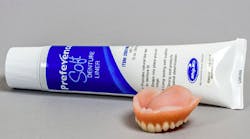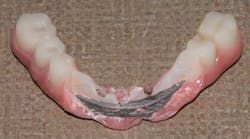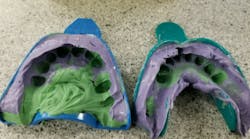Dental lab tech shares lessons learned using Preference Soft Denture Liner
1. It's a versatile material
We've learned that Preference Soft Denture Liner is a very versatile material and should be considered for use in other applications in addition to a regular soft reline. The softness and resiliency of the material have lent it to use 1) in saving a 30-year-old ramus blade implant case, 2) an obturator case where the surgical defect extended over both the hard and soft palate, 3) a lower long extension to the floor of the mouth to engage an undercut, and 4) a case on a custom appliance for a 4-year-old suffering from Dentogenesis Imperfecta. It is also being used in Gasket cases, and of course, as a soft, long-term reline.
2. Sometimes more is better
We have noted that in thin areas it is best to find 2 mm of thickness for the liner. Where extra thickness occurs (like the obturator), it is best to support as much as possible with acrylic and allow for some extra curing time.
3.Sharp acrylic junction edges should be softened/free Monomer avoidedSharp acrylic junction edges should be softened because the liner material can be cut as it stretches across these spots. Excess or free Monomer inhibits the set of this material. If you have just done an acrylic repair, especially when using the "salt and pepper" technique, be sure that you scrub the denture surfaces and the model with Dawn dish washing soap (regular blue with no additives) and clean all surfaces thoroughly with acetone (100%, no additives) before the application of the liner.
RELATED READING:Whip Mix introduces MaxAlign app for capturing patient data
The dental lab's complete guide to better lab-dentist communication
4. Take advantage of undercuts, bony extensions, and flabby tissue
As you inspect the impression and the model, find any and all undercuts, bony extensions, and flabby tissue and use them to help keep the denture in place. The Preference liner material will flow into, around, and under these spots and contribute to the retention. Also, don’t be afraid to do extensions of the lingual borders clear to the floor of the mouth. Use acrylic as far as possible and then let the Preference go the remainder of the way. We have extended as much as 1.5 cm of unsupported Preference to engage an undercut with great success in stabilizing a lower denture.
Many of these procedures could not have been accomplished with standard chairside soft liners or many of the lab liners now on the market and be expected for any extended length of service.
5. A custom tray impression may be needed
The impression you need may require a custom tray and not the current denture as the tray. If this is the case, have the doctor take that custom tray impression of the current oral condition Also do a quick chairside in the existing denture. Pour the model of the custom, then place the chairside with the denture on the custom model prior to doing the “Feet.” This will get you your vertical dimension with the denture in place.
As we continue to experiment with Preference Denture Soft Liner, we will report our findings. But as I have said before, don't limit your thinking on the application of this material. Find a way, by being creative and inventive, to help your doctors help their patients. Even patients who are edentulous deserve a great smile and a great experience. You, along with Preference Soft Denture Liner, can be their path to both.
For the most current dental headlines, click here.
This article originally appeared on the Whip Mix Blog.



